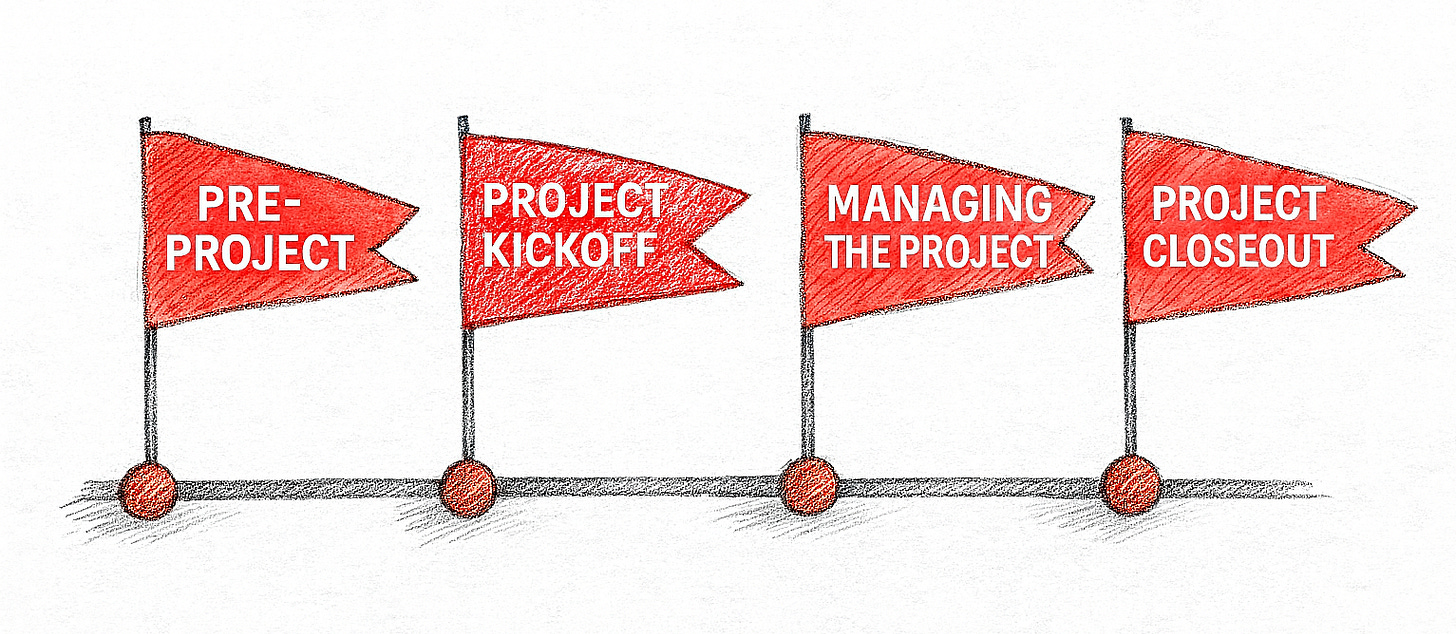Project Management in Emergency Management | A Playbook
As an emergency manager, you already have a lot on your plate—planning initiatives underway, exercises in development, after-action reports to write, and improvement plans to complete. Learning how to manage projects well isn’t about adding another task—it’s about ensuring the work you’re already doing gets done.
When your preparedness projects are managed effectively, your team can respond faster, recover more quickly, and protect your community more effectively when disaster strikes.
We’re writing this Playbook for emergency managers, because their projects—and how well they’re run—touch all of us. But the same principles apply far beyond disaster preparedness. The phases that drive projects are the same ones that guide military operations, business capabilities, and community-based missions anywhere people organize to make an impact.
This Playbook provides a clear, step-by-step framework to manage preparedness projects with purpose and precision. It gives emergency managers—and anyone leading mission-driven work—the structure to keep projects on track, the tools to drive progress, and the confidence to move from planning to execution. The result is meaningful impact when it matters most.
Take control of your projects. Better projects lead to better preparedness.
This Playbook is available through The CP Journal Academy, as part of a paid subscription.
Table of Contents
Section 1 | Laying the Foundation
Chapter 1 | Let’s Get One Thing Clear (Public Article)
Chapter 2 | Why PM in EM Matters | Part 1
Chapter 3 | Why PM in EM Matters | Part 2
Chapter 4 | The Project Manager | Defined
Chapter 5 | The Project Executive is Not the PM
Chapter 6 | How to Use This Playbook
Bonus Chapter | PM in EM: A Career Accelerator (Public Article)
Bonus Chapter | Should I learn agile or waterfall approaches? Both
Prequel Section | Project Selection
Chapter 1 | Strategic Capabilities and Scenario Planning
Chapter 2 | How a “Project Management Office” Structure Can Improve How You Prepare (Public Article)
Chapter 3 | Beyond the Illusion of Capability: A leader’s guide to replacing assumption with clarity, rigor, and readiness. (Public Article)
Chapter 3 | Five Steps to Assess Your Capabilities and Programs
Chapter 4 | Getting the Exercise Type Right
Chapter 5 | Comprehensive Planning for Active Threat Incidents
Chapter 6 | How the Shape of Your Preparedness Cycle Impacts Your Readiness (Public Article)
Section 2 | Project Kickoff
Chapter 1 | So It Begins | Project Kickoff (Public Article)
Chapter 2 | The Project Management Plan
Chapter 3 | Defining “Done” | Setting Your Project Goals
Chapter 4 | Project Design: Turning Goals Into a Roadmap
Chapter 5 | Stakeholder Identification and Engagement Planning
Chapter 6 | Building the Team That Delivers
Chapter 7 | From Tasks to Costs: Building a Project Budget That Works
Chapter 8 | The Project Kickoff Meeting
Chapter 9 | How Fast Can You Launch? Completing a Kickoff That Counts
Bonus Chapter | The Three Questions Every Project Team Should Answer on Day One (Public Article)
This Playbook is a living resource, built from our client work and updated routinely with new lessons. It evolves as we concentrate on the areas most important to advancing emergency management readiness.
Right now, we’ve finalized the “Project Kickoff” section and are focusing on Section 4: Project Closeout.
Section 3 | Managing the Project
Chapter 1 | Getting The Job Done (Public Article)
Chapter 2 | Learning, Discovery, and Analysis
Part 1: Standing on the Shoulders of Giants | The Document Review
Part 2: From “On Paper” to “In Practice” | Initial Stakeholder Interviews
Chapter 3 | Leading the Project Team
Chapter 4 | Surging Resources to the Project
Chapter 5 | On-Going Project Management
Section 4 | Closing out the Project
Chapter 1 | The Discipline of Done | The Project Closeout
Chapter 2 | The Archive
Chapter 3 | What Comes Next: Recommendations and Lessons Learned
Chapter 4 | The Project Closeout Meeting
Chapter 5 | The Post-Project Roadshow
Chapter 6 | Improving Your Process
Chapter 7 | Closing The Playbook

